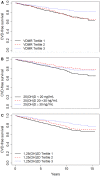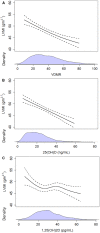Vitamin D Metabolites and Risk of Cardiovascular Disease in Chronic Kidney Disease: The CRIC Study
- PMID: 37421259
- PMCID: PMC10382125
- DOI: 10.1161/JAHA.122.028561
Vitamin D Metabolites and Risk of Cardiovascular Disease in Chronic Kidney Disease: The CRIC Study
Abstract
Background The ratio of 24,25-dihydroxyvitamin D3/25-hydroxyvitamin D3 (vitamin D metabolite ratio [VDMR]) may reflect functional vitamin D activity. We examined associations of the VDMR, 25-hydroxyvitamin D (25[OH]D), and 1,25-dihydroxyvitamin D (1,25[OH]2D) with cardiovascular disease (CVD) in patients with chronic kidney disease. Methods and Results This study included longitudinal and cross-sectional analyses of 1786 participants from the CRIC (Chronic Renal Insufficiency Cohort) Study. Serum 24,25-dihydroxyvitamin D3, 25(OH)D, and 1,25(OH)2D were measured by liquid chromatography-tandem mass spectrometry 1 year after enrollment. The primary outcome was composite CVD (heart failure, myocardial infarction, stroke, and peripheral arterial disease). We used Cox regression with regression-calibrated weights to test associations of the VDMR, 25(OH)D, and 1,25(OH)2D with incident CVD. We examined cross-sectional associations of these metabolites with left ventricular mass index using linear regression. Analytic models adjusted for demographics, comorbidity, medications, estimated glomerular filtration rate, and proteinuria. The cohort was 42% non-Hispanic White race and ethnicity, 42% non-Hispanic Black race and ethnicity, and 12% Hispanic ethnicity. Mean age was 59 years, and 43% were women. Among 1066 participants without prevalent CVD, there were 298 composite first CVD events over a mean follow-up of 8.6 years. Lower VDMR and 1,25(OH)2D were associated with incident CVD before, but not after, adjustment for estimated glomerular filtration rate and proteinuria (hazard ratio, 1.11 per 1 SD lower VDMR [95% CI, 0.95-1.31]). Only 25(OH)D was associated with left ventricular mass index after full covariate adjustment (0.6 g/m2.7 per 10 ng/mL lower [95% CI, 0.0-1.3]). Conclusions Despite modest associations of 25(OH)D with left ventricular mass index, 25(OH)D, the VDMR, and 1,25(OH)2D were not associated with incident CVD in chronic kidney disease.
Keywords: cardiovascular disease; chronic kidney disease; vitamin D.
Figures



Similar articles
-
Vitamin D supplementation for chronic liver diseases in adults.Cochrane Database Syst Rev. 2017 Nov 3;11(11):CD011564. doi: 10.1002/14651858.CD011564.pub2. Cochrane Database Syst Rev. 2017. Update in: Cochrane Database Syst Rev. 2021 Aug 25;8:CD011564. doi: 10.1002/14651858.CD011564.pub3. PMID: 29099543 Free PMC article. Updated.
-
Effectiveness and safety of vitamin D in relation to bone health.Evid Rep Technol Assess (Full Rep). 2007 Aug;(158):1-235. Evid Rep Technol Assess (Full Rep). 2007. PMID: 18088161 Free PMC article.
-
Association Between APOL1 Genotypes and Risk of Cardiovascular Disease in MESA (Multi-Ethnic Study of Atherosclerosis).J Am Heart Assoc. 2017 Dec 21;6(12):e007199. doi: 10.1161/JAHA.117.007199. J Am Heart Assoc. 2017. PMID: 29269352 Free PMC article.
-
Smoking cessation for secondary prevention of cardiovascular disease.Cochrane Database Syst Rev. 2022 Aug 8;8(8):CD014936. doi: 10.1002/14651858.CD014936.pub2. Cochrane Database Syst Rev. 2022. PMID: 35938889 Free PMC article.
-
Vitamin D supplementation for chronic liver diseases in adults.Cochrane Database Syst Rev. 2021 Aug 25;8(8):CD011564. doi: 10.1002/14651858.CD011564.pub3. Cochrane Database Syst Rev. 2021. PMID: 34431511 Free PMC article.
Cited by
-
Risk factors for hip and vertebral fractures in chronic kidney disease: the CRIC study.J Bone Miner Res. 2024 May 2;39(4):433-442. doi: 10.1093/jbmr/zjae021. J Bone Miner Res. 2024. PMID: 38477777 Free PMC article.
-
Association of 1,25 dihydroxyvitamin D with left ventricular hypertrophy and left ventricular diastolic dysfunction in patients with chronic kidney disease.PLoS One. 2024 May 9;19(5):e0302849. doi: 10.1371/journal.pone.0302849. eCollection 2024. PLoS One. 2024. PMID: 38722953 Free PMC article.
-
Vitamin D Supplementation in Heart Failure-Confusion Without a Cause?Nutrients. 2025 May 28;17(11):1839. doi: 10.3390/nu17111839. Nutrients. 2025. PMID: 40507108 Free PMC article. Review.
-
The role of nutritional vitamin D in chronic kidney disease-mineral and bone disorder in children and adults with chronic kidney disease, on dialysis, and after kidney transplantation-a European consensus statement.Nephrol Dial Transplant. 2025 Apr 1;40(4):797-822. doi: 10.1093/ndt/gfae293. Nephrol Dial Transplant. 2025. PMID: 39875204 Free PMC article.
References
Publication types
MeSH terms
Substances
Grants and funding
- UL1 TR000424/TR/NCATS NIH HHS/United States
- U01 DK060963/DK/NIDDK NIH HHS/United States
- R01 DK119199/DK/NIDDK NIH HHS/United States
- UL1 TR000003/TR/NCATS NIH HHS/United States
- R01 DK099199/DK/NIDDK NIH HHS/United States
- UL1 TR000439/TR/NCATS NIH HHS/United States
- P30 DK035816/DK/NIDDK NIH HHS/United States
- UL1 RR029879/RR/NCRR NIH HHS/United States
- U01 DK061028/DK/NIDDK NIH HHS/United States
- UL1 TR000433/TR/NCATS NIH HHS/United States
- F32 DK128986/DK/NIDDK NIH HHS/United States
- U01 DK060984/DK/NIDDK NIH HHS/United States
- U01 DK061021/DK/NIDDK NIH HHS/United States
- U24 DK060990/DK/NIDDK NIH HHS/United States
- U01 DK060980/DK/NIDDK NIH HHS/United States
- U01 DK061022/DK/NIDDK NIH HHS/United States
- K24 HL150235/HL/NHLBI NIH HHS/United States
- P20 GM109036/GM/NIGMS NIH HHS/United States
- U01 DK060902/DK/NIDDK NIH HHS/United States
- UL1 RR024131/RR/NCRR NIH HHS/United States
- U01 DK060990/DK/NIDDK NIH HHS/United States
- T32 DK007467/DK/NIDDK NIH HHS/United States
- R01 DK110087/DK/NIDDK NIH HHS/United States

